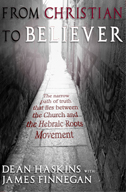The Good Friday Lie
TO WATCH AN ENTIRE SEDER, CLICK HERE
The spirit that invented the Christ-mass is the same one that created the counterfeit the world celebrates called Easter—which was devised to blind people regarding the true meanings of Passover. And, in that deception, there are myriad misunderstandings regarding when Christ was crucified (it wasn't on a Friday), and the true reasons He rose again on the first day of the week following Passover.
While Passover is a vitally important feast day, all of which are Yah's Sabbaths, it was not a high Sabbath during which work was prohibited. It is actually called the preparation day for the next day's feast, which is Unleavened Bread. Of course, Unleavened Bread is a high Sabbath, and thus, work was not permitted. It is important to understand this, because much of the church misinterprets scripture that refers to this preparation day.
In Luke 23:54, we read of the day Christ was crucified, “And that day was the preparation, and the sabbath drew on.” Many erroneously claim that this is speaking of Friday, the day before the weekly Sabbath, but that is not true. It is speaking of the annual Sabbath Feast of Unleavened Bread. The historical record provides the insight that this year was most likely AD 31, and in that year, the preparation day, or Passover, fell on a Wednesday, which would make the Feast of Unleavened Bread fall on Thursday.
Note that in Luke 23:55-56 we are told:
And the women also, which came with him from Galilee, followed after, and beheld the sepulchre, and how his body was laid. And they returned, and prepared spices and ointments; and rested the sabbath day according to the commandment.
We know from scripture that Christ died at the ninth hour, or around 3 PM. Unleavened Bread would begin at sundown. So, from 3 PM until sundown on Passover, having to prepare and bury the body, and also walk home, there would have been no time left to do the work of buying and preparing spices and perfumes, since the women had followed the body to the tomb, and had watched it being lain there, according to Matthew 27:59-61, which states, “And when Joseph had taken the body, he wrapped it in a clean linen cloth, and laid it in his own new tomb, which he had hewn out in the rock: and he rolled a great stone to the door of the sepulchre, and departed. And there was Mary Magdalene, and the other Mary, sitting over against the sepulchre.”
In Matthew 27:62-66, we're told, “Now the next day, that followed the day of the preparation, the chief priests and Pharisees came together unto Pilate, Saying, Sir, we remember that that deceiver said, while he was yet alive, After three days I will rise again. Command therefore that the sepulchre be made sure until the third day, lest his disciples come by night, and steal him away, and say unto the people, He is risen from the dead: so the last error shall be worse than the first. Pilate said unto them, Ye have a watch: go your way, make it as sure as ye can. So they went, and made the sepulchre sure, sealing the stone, and setting a watch.”
Mark 16:1-2 provides even more clarification: “And when the sabbath was past, Mary Magdalene, and Mary the mother of James, and Salome, had bought sweet spices, that they might come and anoint him. And very early in the morning the first day of the week, they came unto the sepulchre at the rising of the sun.”
We already know the women were at the tomb when Christ was lain there, and that when sundown came, it was the Feast of Unleavened Bread—a high Sabbath. We know the women rested on Thursday (no work could be done other than food preparation according to Exodus 12:16 on that day). Then, on Friday, they bought and prepared the spices and perfumes. Even though the body had been wrapped with spices that had been provided by Nicodemus (John 19:39), the women fully intended that someone would roll away the stone, and they would apply more perfumes and spices to the body. But, Saturday was the weekly Sabbath, and they rested that day, so that is why they waited until Sunday morning to visit the tomb with perfumes and spices (although, He had risen hours before, during the night).
The women had no way of knowing the tomb had been sealed, since they would not have traveled to it until Sunday. In fact, when the women were walking to the tomb early Sunday morning, they apparently did not know at that point that the tomb had been sealed, for in Mark 16:2-3, we're told, “And very early in the morning the first day of the week, they came unto the sepulchre at the rising of the sun. And they said among themselves, Who shall roll us away the stone from the door of the sepulchre?” They would not have asked that question if they were aware that the stone had been sealed, and was being guarded.
Jews of that day believed that a person was not legally dead until after three days, which is why Christ waited until the fourth day to resurrect Lazarus (John 11:39). And, it was a common practice to go back to the body after it had been buried, and place additional perfumes and spices on it to defuse the smell of decay that would waft from it out to those who were mourning outside the tomb. Of course, even though Sunday was a Sabbath (Feast of Firstfruits), it was not a non-working Sabbath, as it was the first day of the barley harvest.
Seeing now the true spiritual meanings inherent within these feast days, why would any believer who knows these truths embrace pagan counterfeits over Yah's ordained traditions?
Excerpted from "From Christian to Believer."
CLICK HERE FOR A DETAILED CHRONOLOGY OF THE PASSOVER/CRUCIFIXION
Click here to download a printable version of the chronology


Written by Dean Haskins for Way of the Tabernacle. Reproductions with proper attribution are allowed and encouraged.
Salvation
Traditions
Other Truths
But now in Yahoshua the Messiah you who formerly were far off have been brought near by the blood of Christ. For He Himself is our peace, who made both groups into one and broke down the barrier of the dividing wall, by abolishing in His flesh the enmity, which is the Law of commandments contained in ordinances, so that in Himself He might make the two into one new man, thus establishing peace, and might reconcile them both in one body to Yah through the cross, by it having put to death the enmity. Ephesians 2:13-16




